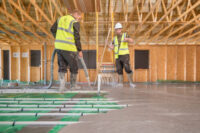The Ultimate Guide to UFH Build Sequencing in Screed for Developers
We understand from our clients that transitioning to a new or possibly an unfamiliar specification can sometimes be viewed as a far more complex switch than it is in reality. In our 16 years of UFH experience, covering a wide range of house specifications, we have consistently and successfully supported developers in that transition to underfloor heating.
Making a UFH Build Sequence work for you
There are no right or wrong ways to sequence UFH as it can be easily accommodated. Reasons for sequencing differently vary, for example:
- Your preferences or ways of working
- Current contractual arrangements or
- Supply and logistics
However, the end goal is always the same, to align UFH so its specification smoothly integrates with how you build your homes.
When can an UFH system in screed be sequenced?
Typically, there are two stages when underfloor heating is sequenced in screed, before or after housing structures are built, both ways are suitable and widely used to successfully incorporate UFH within residential new-build.
Some considerations for both sequences:
- Forward planning of potential changes to heated or unheated areas
- Chronological sequencing of screeder to limit UFH pipes being exposed for long periods unnecessarily
- Future proof for potential position changes, and although it is very rare that manifold positions need to be changed after initial install it is important that it can be easily and quickly amended without unnecessary expenses incurred
Therefore:
- Use straight connectors and pipe lengths to relocate
- Pipes can be hidden in voids, behind walls or a very small chase out of the screed a short distance to new location
UFH in screed is installed in the following way:
- Insulation is laid onto a concrete slab
- UFH pipes are laid over and clipped to the insulation
- Screed is poured
Sequence One: Before housing structures are built (Oversite stage)

Where screed is poured at the beginning of the development, before walls and housing structures have been built.
Further Considerations (which differ from the ‘after housing structures are built’ sequence)
- Manifold location to be marked on the floor in accordance with design
- Manifold back board mounted for pressure testing
- Ambiente manifold sheet covers to protect during period before structures are built
Sequence Two: After housing structures are built

Where screed is poured after walls and house structures have been erected.
The main difference with this sequence is that you may have a little more flexibility in how you adapt to any potential design changes at installation, before pipes are laid in screed. However, for potential design changes after pipes are laid in screed you will still need to future proof in the same way.
Further Considerations (which differ to oversite stage)
- Manifold: Wall mounted for pressure testing at location in
accordance with design - Ambiente manifold sheet covers to protect during period before boxing in and installation of units
If you are considering UFH for your developments and would like to further details please contact Sturge at Ambiente Systems on 01707 649 118.
sturge@ambienteufh.co.uk
Connect with me on LinkedIn
GET IN TOUCH TODAY
This article was written by Sturge Mazzocchi, Account Manager at Ambiente for Group Deals and Key Accounts.
Working closely with housebuilders and large organisations, in the drive toward successfully adopting low carbon heating systems, throughout what is one of the most critical periods of change within the new build residential industry.
